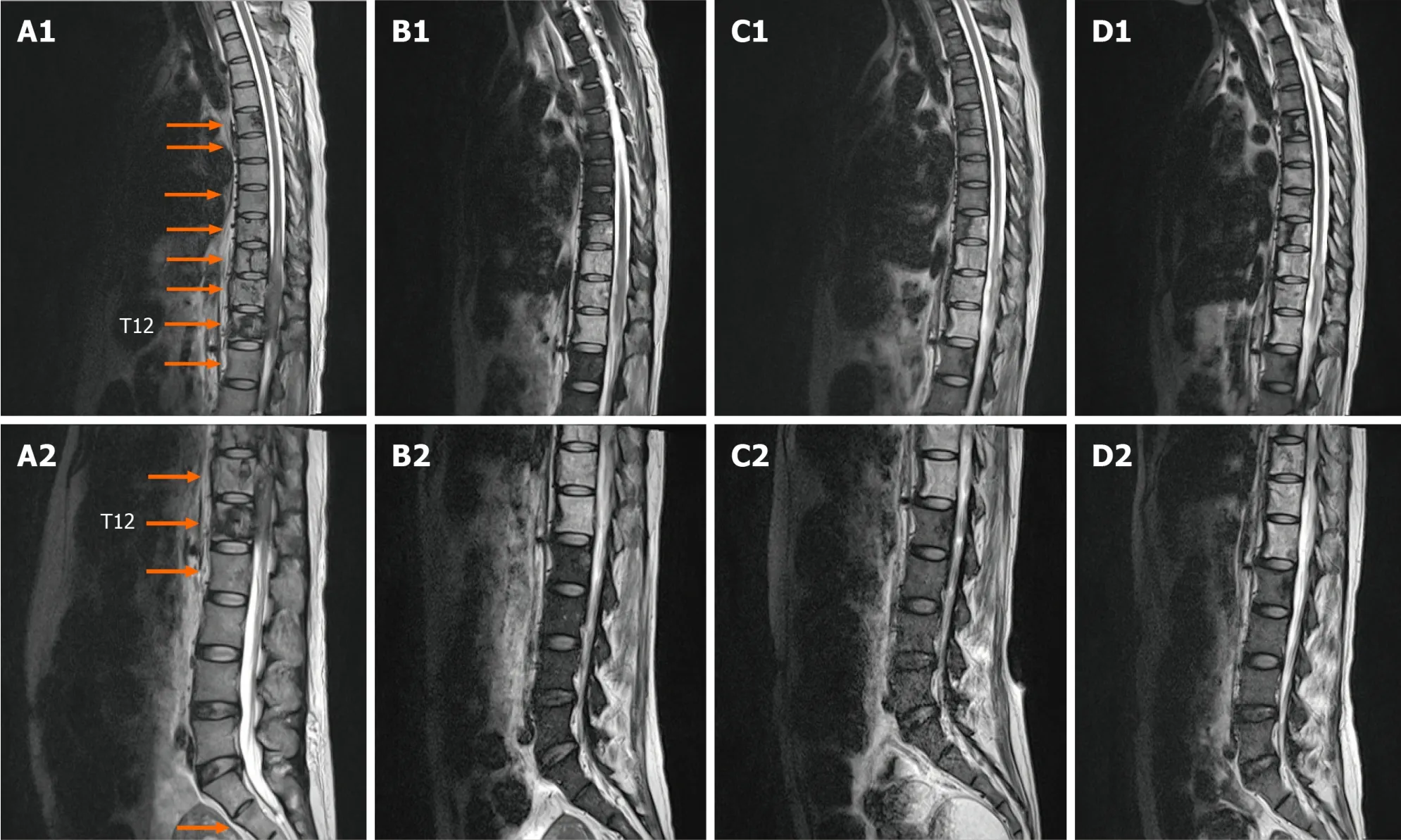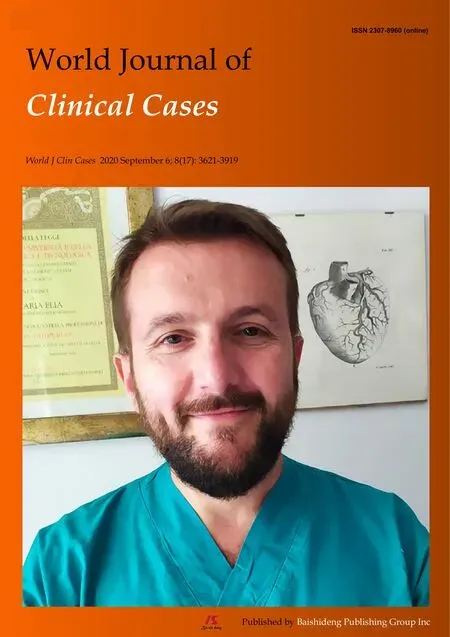Multidisciplinary treatment of life-threatening hemoptysis and paraplegia of choriocarcinoma with pulmonary,hepatic and spinal metastases:A case report
Yuan-Yuan Lin,Yang Sun,Yu Jiang,Bao-Zhi Song,Li-Juan Ke
Yuan-Yuan Lin,Yang Sun,Department of Gynecology,Fujian Cancer Hospital,Affiliated Cancer Hospital of Fujian Medical University,Fuzhou 350014,Fujian Province,China
Yuan-Yuan Lin,Yu Jiang,Bao-Zhi Song,Li-Juan Ke,Department of Gynecology,Shengli Clinical Medical College of Fujian Medical University,Fujian Provincial Hospital,Fuzhou 350001,Fujian Province,China
Abstract
Key words:Choriocarcinoma;Metastases;Multidisciplinary treatment;Case report;Actinomycin D
INTRODUCTION
Choriocarcinoma is a highly malignant form of gestational trophoblastic disease that spreads rapidly throughout the body[1].It can metastasize or infiltrate into adjacent tissues including the tubes and ovaries or spread to distant sitesviablood circulation.The most common sites of metastases are the lungs,vagina,liver,brain and digestive tracts.Spinal metastasis of choriocarcinoma is extremely rare[2].Moreover,the common symptom is most frequently hemorrhage due to metastases,presenting as vaginal bleeding,hemoptysis or hematemesis.
Modern treatment of choriocarcinomas involves chemotherapy followed by radiation or surgery,resulting in a cure rate approaching 90%.However,drugs commonly used for cancer treatment have barriers such as drug resistance and side effects[3].Furthermore,the optimal treatment strategies for metastatic choriocarcinomas remain controversial.Therefore,a collaboration of multidisciplinary providers may help with development of novel treatment strategies that can maximize efficacy and minimize toxic effects.This is especially beneficial as new strategies for the stable treatment of metastatic choriocarcinoma are urgently needed in some patients.Chemotherapy in combination with other treatments may be a strategy that opens the door to promising therapeutic options.
CASE PRESENTATION
Chief complaints and history of present illness
A 40-year-old woman attended the emergency department on December 18,2017 for progressively increasing hemoptysis of half month’s duration.At first,the patient presented with coughing and slight hemoptysis along with lower back pain,though she denied having dizziness or headache.The attending physician diagnosed the patient with pneumonia;however no improvement was observed with the use of antibiotics or high doses of corticosteroids.The symptoms,especially the hemoptysis,had worsened in the past half month with progressive lower limb weakness.
History of past illness
Her medical history included cesarean on three occasions,the last occurring about 10 mo prior to hospitalization.The postpartum lochia after the latest cesarean was minimal.Six months postpartum,menstruation resumed with occasional intermittent vaginal spotting.
Physical examination
The patient demonstrated distressed breathing and backache.Lung examination revealed bilateral lung crackles.Neurological examination revealed the loss of all sensations below the Th10 level with flaccid paraplegia.Vaginal examination wasnormal.
Laboratory examinations
Laboratory tests revealed a white blood cell count of 15.3 × 109/L,neutrophil count of 14.4 × 109/L and hemoglobin of 10.9 g/dL (Table 1).Blood gas analysis showed (FiO249%):PH 7.47,PaO257.3 mmHg,PaCO234.5 mmHg and OI 117 mmHg.Serum βhuman chorionic gonadotropin (β-hCG) was 58162.0 IU/L (Figure 1).A repeat β-hCG showed a continuously rising trend,up to 100014.0 IU/L.
Imaging examinations
Repeat transvaginal ultrasound with Doppler showed a thin endometrial lining and normal color bloodstream signal in the endometrial cavity.Ultrasonography of the abdomen revealed multiple masses in the liver.The biggest was approximately 31 mm× 25 mm.Chest computed tomography (CT) revealed nodular opacity lesions distributed in both lungs (Figure 2).Spinal magnetic resonance imaging revealed multiple mass lesions at the portion of the body aligning at the Th5-6,Th8-12,L1 and S2 levels and involving the dorsal portion of the spinal canal at the Th9–L1 level(Figures 3 and 4).Cranial CT was normal.
在《蒲团》中,大约36岁左右,在妻子和3个孩子的某作家竹中时雄,名叫横山芳子的女学生想要拜入他的门下,开始没有兴趣的时雄,在和芳子在写信的过程中看到了那个未来性,结下了师徒的关系,由此芳子来到了东京。芳子的恋人田中秀夫也跟着芳子进京。时雄为了监视,让芳子住在自己家的二楼。然而,芳子和秀夫的关系已经超越了时雄的想象,生气的时雄打破了芳子和父亲一起回去。在作品中,“牺牲”这个词经常出现。作品中其实有两种“牺牲”。一个是竹中自己称为“悲壮的牺牲”,另一个是芳子最后回到老家的事实上的“悲壮的牺牲”。这两种牺牲一明一暗,在对比中突出了男女在爱情选择上的差异,也反映了当时的社会背景。
FINAL DIAGNOSIS
According to these findings,the patient was classified as ultrahigh-risk (score 16)based on the World Health Organization prognostic scoring system.The patient was diagnosed with stage IV choriocarcinoma and concomitantly with type 1 respiratory failure and paraplegia.
TREATMENT
During her second day of hospitalization,the patient developed an episode of sudden hemoptysis resulting in hypovolemic shock,and hemoglobin levels decreased to a low of 5.8 g/dL.Bedside fiberoptic bronchoscopy showed a massive accumulation of blood in the distal trachea.Repeated vasopressin was administered locally,and antibiotics and blood transfusion were also given.However,the patient did not improve.The patient was alleviated by trachea reintubation with mechanical ventilation,but hemoptysis remained serious.
Subsequently,a multidisciplinary team was set up quickly,including gynecology oncologists,respiratory physicians,neurologist,surgeons,radiologists,Chinese pharmacists and physiatrists.After careful consideration and fully informed consent,the patient took the risk of receiving an urgent regimen of 5-d actinomycin D (10 μg/kg per day for 5 d) as primary chemotherapy.After one cycle of chemotherapy,hemoptysis was significantly reduced,and the patient was weaned from mechanical ventilation and referred to the gynecology ward.
In the gynecology ward,the standard multiagent chemotherapy regimen using EMA-CO (etoposide,methotrexate,actinomycin-D,vincristine and cyclophosphamide) was initiated.As supportive therapy,granulocyte colonic stimulating factor,thrombopoietin,dexamethasone,traditional Chinese medicine and external treatment,including acupuncture,acupoints and therapeutic type exercise,were also given when necessary.After six cycles of chemotherapy,the serum β-hCG level was 19.0 IU/L,however the patient continued to experience unbearable lower back pain requiring morphine.Later,the characteristic multiagent chemotherapy regimen using FAEV(floxuridine,dactinomycin,etoposide and vincristine) was started.During this chemotherapy interval,the patient underwent 18 radiotherapy sessions to the thoracic and lumbar spine with a total dose of 36 Gy in the form of intensity-modulated radiation therapy.After radiation,the pain subsided completely,and the patient gradually recovered partial mobility.A repeat spinal magnetic resonance imaging showed the nodular images in the centrum regressed (Figures 3 and 4).However,abdominal CT revealed multiple,persistent nodular lesions in the liver;the largest measured approximately 3.0 cm × 2.4 cm.After CT-mediated percutaneous radiofrequency ablation of the right liver,metastatic foci of the liver were shrunk.Despite this,the patient progressed with total increasing levels of β-hCG approaching 40.0 IU/L.Due to cerebrospinal fluid β-hCG levels of 20.6 IU/L,the patient received eight cycles of the second-line chemotherapy regimen using EMA-EP (methotrexate,etoposide,actinomycin D,etoposide and cisplatin),including four cycles of consolidation chemotherapy as well as four cycles of intrathecal methotrexate injections.After the administration of intrathecal methotrexate injections,the β-hCG level in the cerebrospinal fluid lowered to 1.6 IU/L.A repeat chest CT demonstrated normal results by the end of the treatment (Figure 2).A detailed record is provided in Figure 1.

Table 1 Demography,clinical and laboratory features both in hospital and reference laboratory
OUTCOME AND FOLLOW-UP
By discharge,the patient had regained some function of her lower extremities (1-2 out of 5 on neurological motor examination).During 1-year follow-up,the patient appeared well,and serial β-hCG estimations were within normal ranges.

Figure 1 A logarithmic graphical representation of the serial β-human chorionic gonadotropin levels as a line graph has been depicted.The X-axis denotes the day after treatment started,and the Y-axis denotes the serum concentration of serial β-human chorionic gonadotropin levels.The arrow represents the start of each course of intravenous chemotherapy.IVC:Intravenous chemotherapy;EMA-CO:Etoposide,methotrexate,actinomycin-D,vincristine,cyclophosphamide;FAEV:Floxuridine,dactinomycin,etoposide and vincristine;EMA-EP:Methotrexate,etoposide,actinomycin D,etoposide and cisplatin;β-hCG:β-Human chorionic gonadotropin;IMRT:Intensity-modulated radiation therapy;RFA:Radiofrequency ablation;ITC:Intrathecal chemotherapy.
DISCUSSION
According to the criteria for nongestational choriocarcinoma diagnosis,the patient was diagnosed with choriocarcinoma with no pathologically confirmed origin site.No visible and palpable lesions in the uterus or adnexa were detected,whereas the lungs,liver and spine showed features of metastases.This case is rare given that the majority of cases of choriocarcinoma are of uterine origin.It could be hypothesized that the rapid growth of the tumors infiltrated the endometrium and myometrium causing regression of the primary tumor then spreading to lungs and the other distant sites by hematogenous metastasis.As metastatic lesions slowly enlarge,they are usually accompanied by hemorrhage,necrosis and vascular invasion.In the lungs,this could cause hemoptysis complicated by infection,which can lead to airway obstruction or even cardiorespiratory failure.In the spine,lesion enlargement can cause backache and progressive impairment of nerves.Clinically,these subtle signs and symptoms could easily be attributed to pulmonary infection and lumbar muscle strain,resulting in misdiagnosis and treatment delay.The findings of this case suggest that the possibility of choriocarcinoma should be borne in mind when a woman of reproductive age presents with metastatic disease of an unknown primary site.
The patient in this case had a risk score of 16 and coexisting pulmonary,hepatic and spinal metastases.Thus,this lesion belonged to a category of ultrahigh-risk gestational trophoblastic neoplasia as designated by the 2018 International Federation of Gynecology and Obstetrics guidelines.Consequently,the tumor subgroup is accompanied by a poor prognosis[4].Women with high risk scores are more likely to develop resistance to single-agent chemotherapy and are therefore likely to benefit from combination chemotherapy.However,because of the severity and urgency of the patient’s general medical condition,initiation of standard chemotherapy or low-dose induction etoposide-cisplatin is usually prescribed and may actually cause metastatic lesion necrosis in large areas,leading to deadly massive hemoptysis,respiratory failure,septicemia or multiple organ failure.Hence,the initial chemotherapy regimen administered to this patient was a mono-therapy “5-d actinomycin D,” adjusted to the standard chemotherapy regimen of EMA-CO,and subsequently FAEV and EMA-EP after the patient’s condition improved.
Hepatic metastasis,however,is not common and is insensitive to chemotherapy.There is currently no consensus on the best management strategy for hepatic metastases.Recent reviews of the management of choriocarcinoma with hepaticmetastasis support benefits of multimodality therapy,including surgical resection[5],local radiotherapy[6]and hepatic artery embolization[7].In the present case,the patient was treated by CT-mediated percutaneous radiofrequency ablation,the advantages of which include safety and effectiveness due to its simplicity and minimal invasiveness.The strategy can be used to destroy target regional tumor cells and the local tumor blood supply,reducing local tumor burden and to some extent minimizing chemotherapy resistance.

Figure 2 Comparison of pulmonary lesions.A:Lung computed tomography before chemotherapy;B:Lung computed tomography after the first chemotherapy;C:Lung computed tomography after the last chemotherapy.
Bone metastases secondary to choriocarcinoma are extremely rare events with poor treatment response.Treatment of bone metastases has consisted of either chemoradiotherapy[8],surgical resection[2]or other combined approach[9].Successful treatment has been reported in only one case,in which the patient was cured by embolization of the lesion of the lumbar spine and subtotal removal of the epidural mass[9].Given the widespread bone involvement in the current case,the patient was not well suited for surgery.Thus,multidrug chemotherapy combined with spinal intensity-modulated radiation therapy was performed.Compared with EMA-CO and EMA-EP ,FAEV chemotherapy obtained longer intervals between cycles with welltolerated toxicity,enabling the patient to receive an adequate course of radiotherapy.By attenuating symptoms of spinal cord compression and alleviating pain,intensitymodulated radiation therapy could potentially achieve the best control of spinal metastasis,though more information is needed to verify this hypothesis.
教师没有以图片、视频或现场等形式引导幼儿观察大公鸡,观察其形态特征,并进一步引发讨论,引导幼儿感知和欣赏大公鸡的美。
Currently,chemotherapy remains the only potentially curative therapy for choriocarcinoma,and surgery and radiotherapy may have roles in certain cases.However,developments in modern medicine could open up new horizons oftreatment options for the clinician.
【案例1】等比数列的求和中,创设“西游记后传”的情景:猪八戒经营某公司,因资金短缺,向猴哥贷款,猴哥爽快地答应了,“我每天给你投资100万元,连续30天,但第一天返还1元,第二天返还2元,第三天返还4元,……每天返还数为前一天的2倍。”八戒乐得手舞足蹈,第一天出1元入100万,第二天出2元入100万,第三天出4元入100万……哇,发财了。如果你是公司高管,你帮八戒决策,它会不会被猴哥甩了。经计算孙悟空大约能拿到10亿多元,学生十分惊讶,产生认知上的冲突,进而迫切想要了解新知识。

Figure 3 Comparison of spinal lesions.A:Spinal magnetic resonance imaging (MRI) revealed T2-weighted scans at the initial presentation;B:Spinal MRI revealed T2-weighted scans before radiation;C:Spinal MRI revealed T2-weighted scans 1 mo after radiation;D:Spinal MRI revealed T2-weighted scans 6 mo after radiation.The arrow points to the bone metastatic lesion area.
CONCLUSION
We have presented the first reported case of choriocarcinoma with pulmonary,hepatic and spinal metastases of unknown specific primary site.Choriocarcinoma should be suspected in any woman of reproductive age with metastatic disease from an unknown primary[10].Moreover,this case demonstrated that administration of 5-d actinomycin D as primary chemotherapy is feasible and tolerable in critical condition,though more cases are needed to verify.The case supports the opinion that by providing a close multidisciplinary collaboration,patients suffering from metastatic choriocarcinoma,especially those with high prognostic scores or extensive metastases,may benefit from the individualized treatment and achieve the best therapeutic results.

Figure 4 Comparison of spinal lesions.A:Spinal magnetic resonance imaging (MRI) revealed enhancement scans at the initial presentation;B:Spinal MRI revealed enhancement scans before radiation;C:Spinal MRI revealed enhancement scans 1 mo after radiation;D:Spinal MRI revealed enhancement scans 6 mo after radiation.The arrow points to the bone metastatic lesion area.
 World Journal of Clinical Cases2020年17期
World Journal of Clinical Cases2020年17期
- World Journal of Clinical Cases的其它文章
- Autoimmunity as the comet tail of COVID-19 pandemic
- Gender medicine:Lessons from COVID-19 and other medical conditions for designing health policy
- Complexities of diagnosis and management of COVID-19 in autoimmune diseases:Potential benefits and detriments of immunosuppression
- Incidental anal 18fluorodeoxyglucose uptake:Should we further examine the patient?
- Emergency surgery in COVID-19 outbreak:Has anything changed?Single center experience
- Somatostatin receptor scintigraphy in the follow up of neuroendocrine neoplasms of appendix
